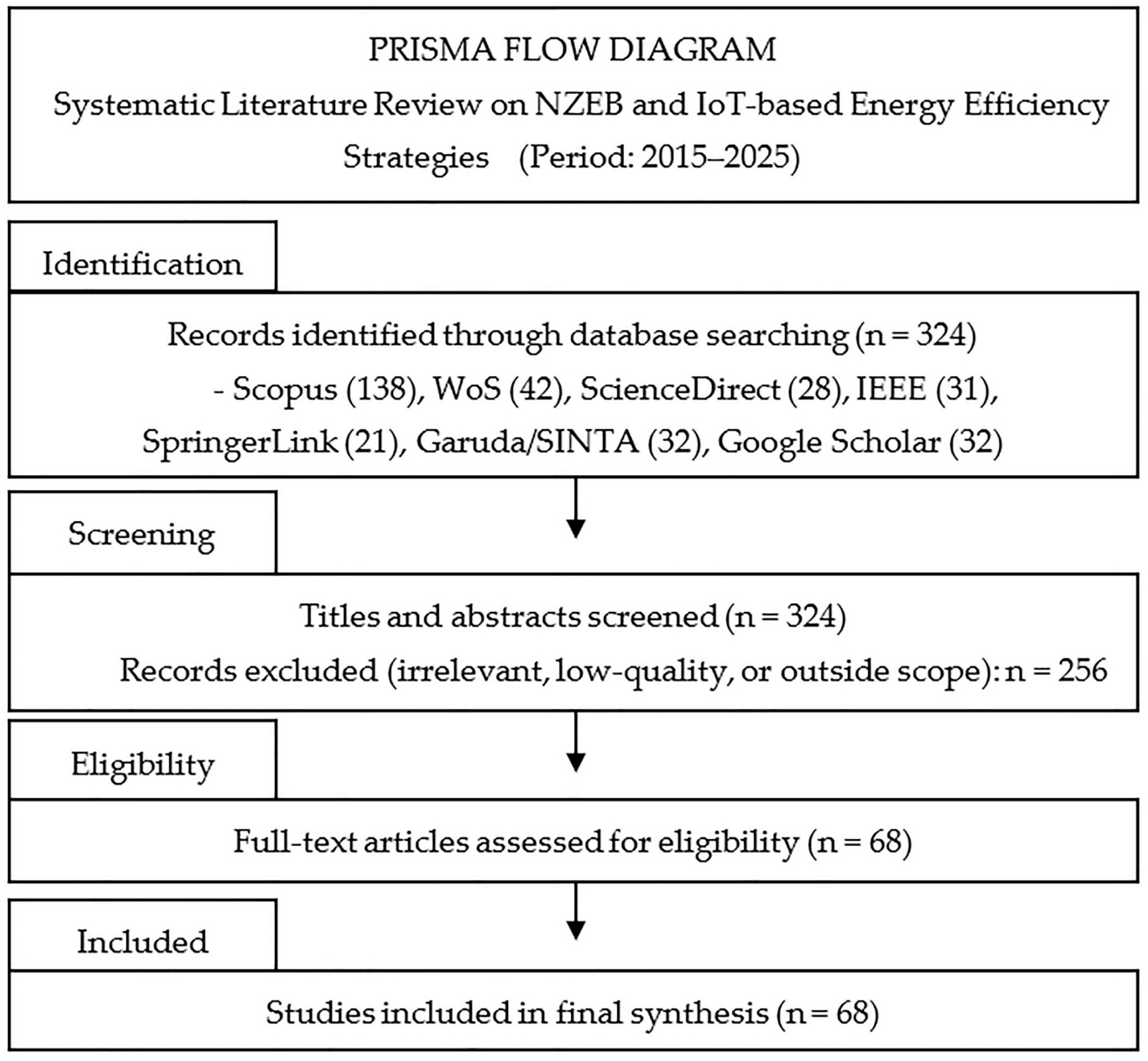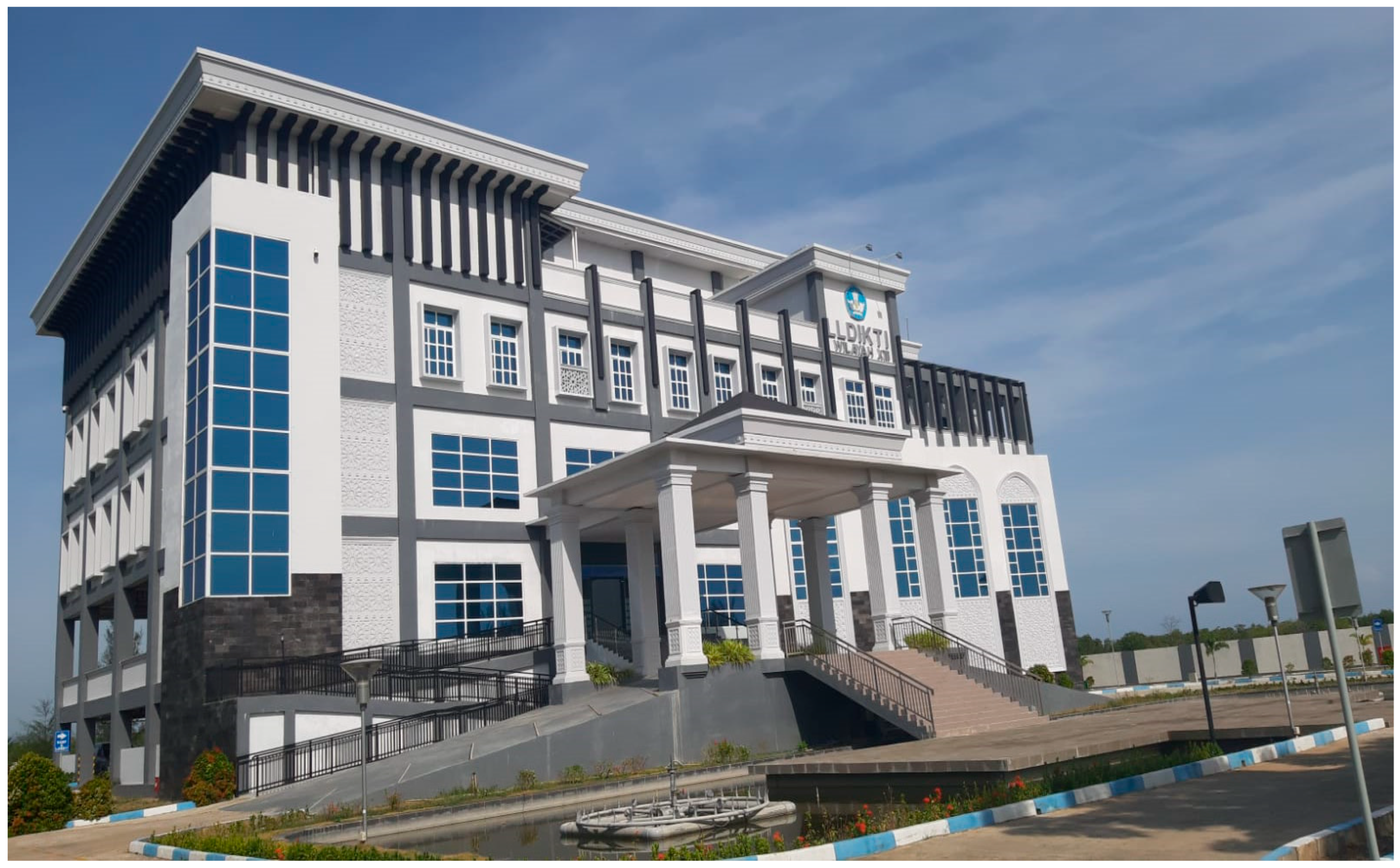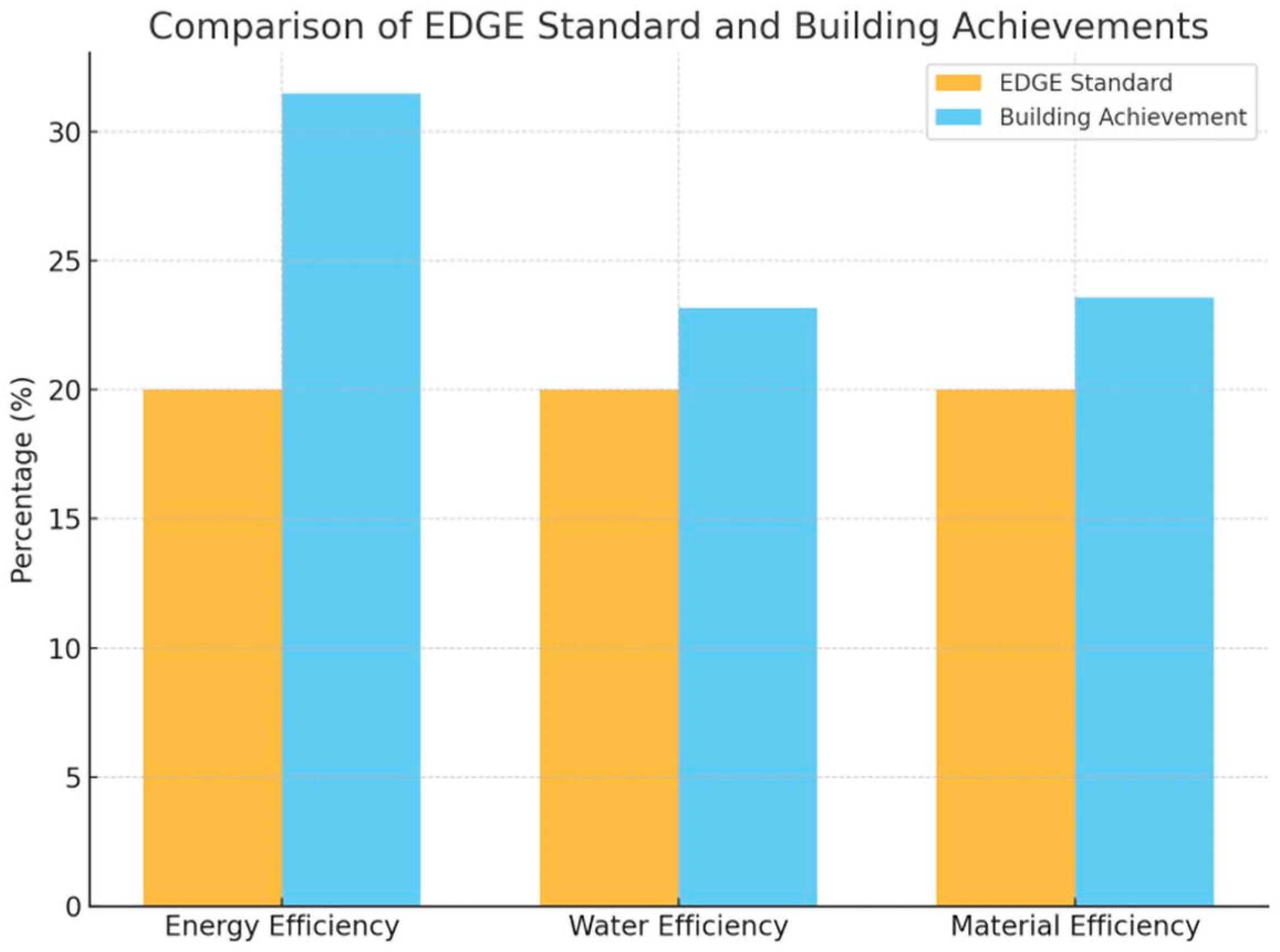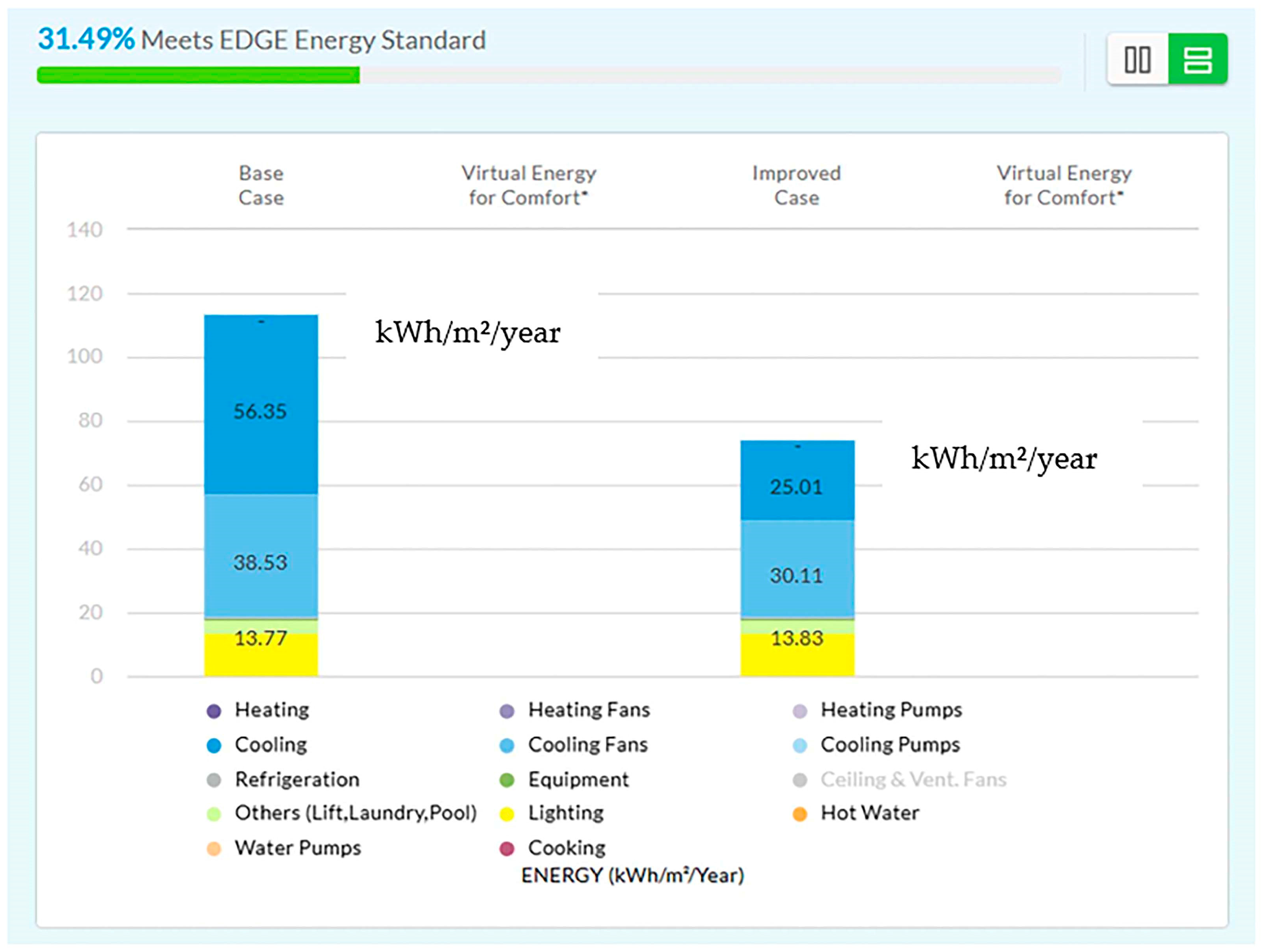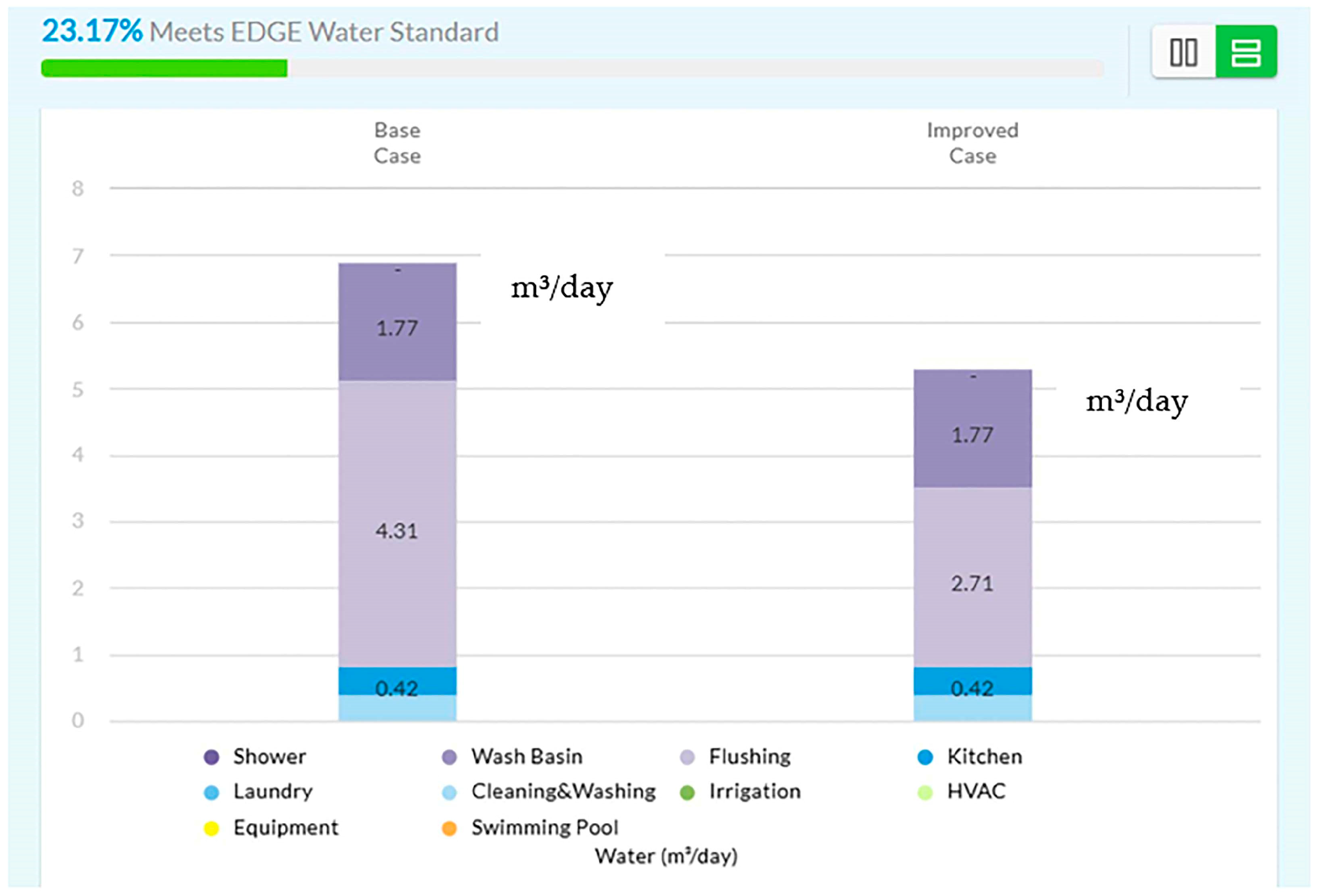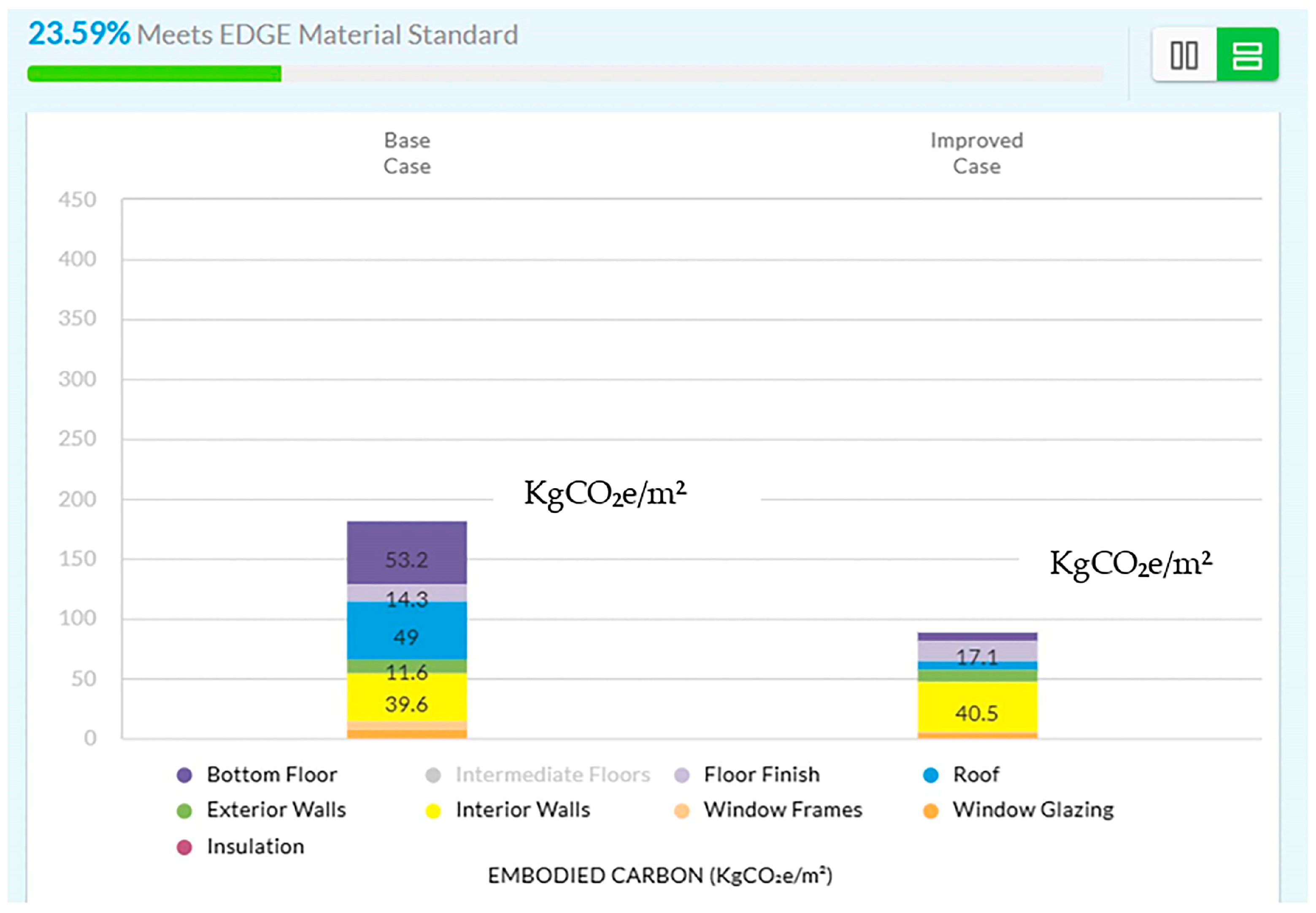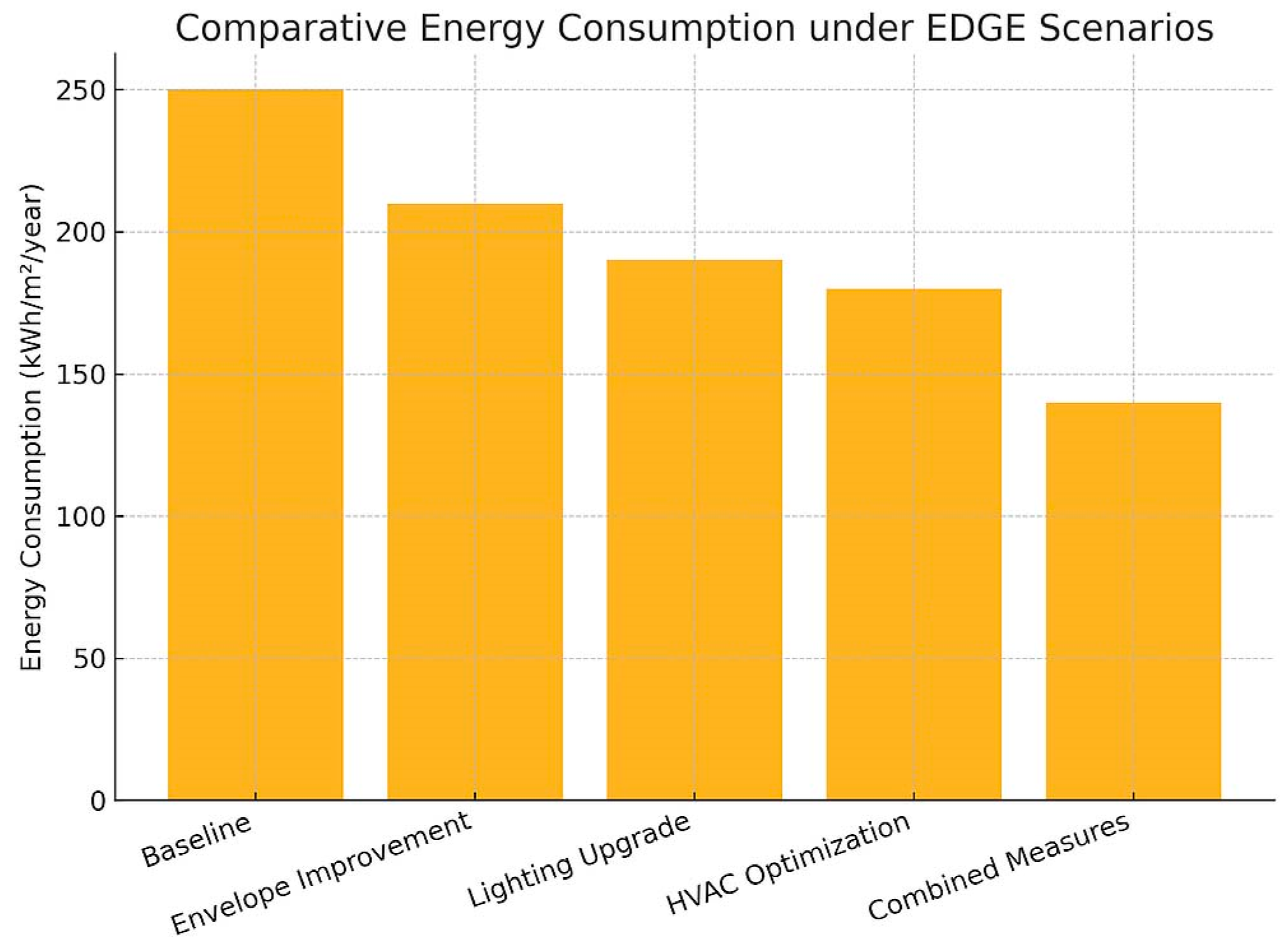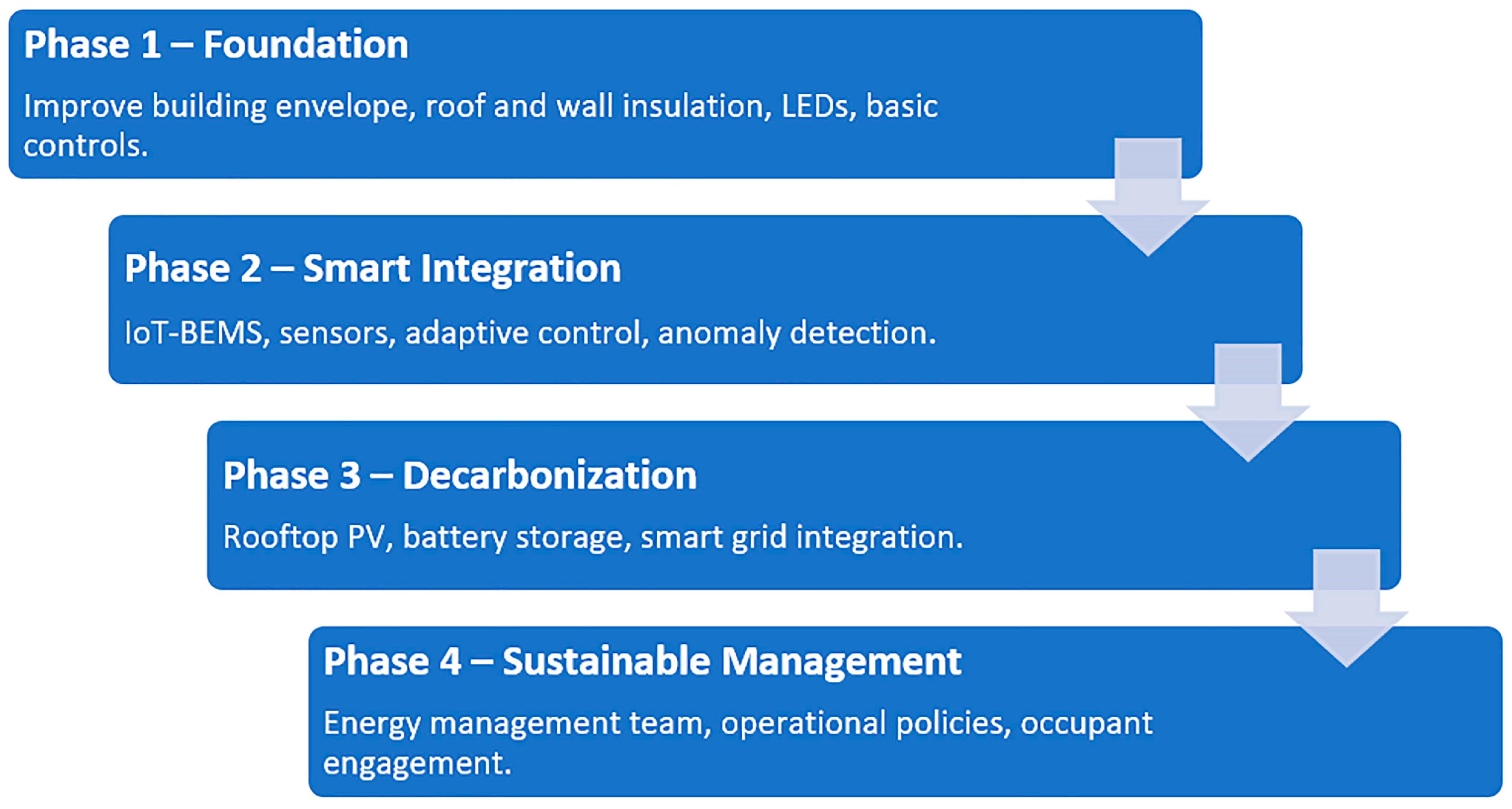1. Introduction
The building sector is among the largest contributors to global energy consumption and carbon emissions, making its decarbonization a central priority in climate change mitigation [
1]. The urgency of transitioning towards an efficient and sustainable built environment is growing in line with the intensifying global challenges of energy and sustainability.
In developing countries with tropical climates, including Indonesia, this issue becomes more complex. Heavy reliance on artificial cooling and lighting systems results in high energy intensity [
2], which is further aggravated by design practices that often neglect passive efficiency measures, thereby increasing dependence on mechanical systems [
3].
To address this, Indonesia has adopted a green building policy since 2004 [
4]. Nevertheless, implementation in practice continues to face various obstacles, ranging from design and operational limitations to restricted technical capacity [
5]. The challenge is even more critical in disaster-prone regions such as Banda Aceh City, where sustainability must be pursued in tandem with building resilience [
6,
7].
Against this policy backdrop, the concept of the Net-Zero-Energy Building (NZEB) has emerged as an effective strategy to reduce carbon emissions by balancing energy consumption with on-site renewable energy production [
8,
9]. Yet the application of NZEBs in tropical climates encounters unique barriers, particularly high cooling loads and humidity. As a result, NZEB strategies cannot be directly replicated from subtropical models but require localized adaptation that emphasizes passive design efficiency, renewable energy integration, and intelligent load management [
10,
11].
Within this framework, the Internet of Things (IoT) presents innovative opportunities. IoT enables real-time monitoring and adaptive control integrated into Building Energy Management Systems (BEMSs), allowing lighting and HVAC systems to operate dynamically based on occupancy, temperature, and environmental conditions [
12,
13]. However, its adoption in Indonesia remains limited due to high upfront investment, insufficient technical expertise, and the absence of standardized implementation frameworks [
14,
15]. Moreover, technologies that incorporate occupants’ preferences and comfort have yet to be widely developed [
16].
The potential of IoT can be further strengthened through digital tools such as Excellence in Design for Greater Efficiencies (EDGE), which provide holistic assessments of building performance [
17,
18]. Through simulations, EDGE can estimate energy savings from multiple interventions, while also supporting decision-making and investment planning processes [
19].
In this context, the LLDIKTI Region XIII Office Building in Banda Aceh was selected as the case study because it represents a typical mid-rise government office operating under tropical climatic conditions, with moderate energy intensity and limited integration of smart control systems. The building’s public ownership, standardized layout, and consistent operational schedule make it an ideal prototype for evaluating how IoT-based monitoring and EDGE simulations can inform policy-oriented replication across Indonesia’s public building sector.
Although research on energy efficiency and IoT has grown substantially, previous studies have mostly focused on residential or educational buildings [
17,
19,
20,
21,
22], leaving a gap in understanding how IoT-integrated frameworks perform in government office environments in tropical cities. Some studies highlight the limitations of constructing NZEBs under tropical conditions due to elevated cooling demands, while others reveal optimism through the combined use of passive and smart technology strategies. However, most existing IoT–BEMS or simulation-based optimization frameworks rely primarily on theoretical modeling or short-term pilot monitoring, often without direct validation using real operational data. Moreover, limited attention has been given to the integration of IoT-derived empirical datasets into EDGE simulations for calibration and scenario testing, particularly within the context of public-sector buildings in humid tropical climates.
This study, therefore, advances prior research by developing and validating a hybrid IoT–EDGE framework that combines continuous real-time monitoring, simulation-based optimization, and adaptive control assessment. The proposed approach provides a replicable model for data-driven NZEB transitions in tropical government buildings, addressing both operational and climatic constraints through evidence-based validation.
To address this research gap, three guiding questions were formulated: (1) How can an IoT-based operational strategy enhance energy efficiency while sustaining occupant comfort in the LLDIKTI Region XIII Office Building in Banda Aceh? (2) To what extent can potential energy savings be achieved through this strategy using EDGE simulations? (3) What operational recommendations can facilitate the transition toward net-zero status?
Aligned with these questions, the study pursues three objectives: first, to develop a comprehensive IoT-based operational strategy framework that enhances energy efficiency while maintaining occupant comfort; second, to evaluate potential energy savings through EDGE simulations; and third, to formulate phased recommendations that support the transformation of buildings toward net-zero energy operation.
The novelty of this study lies in its hybrid methodological approach that combines IoT-based real-time monitoring with EDGE simulation to evaluate operational efficiency in tropical office settings—a combination rarely addressed in existing literature. From an academic perspective, it enriches the literature on the application of IoT to support NZEB development in tropical climates. From a practical standpoint, it introduces a replicable framework for government buildings in Indonesia, thereby advancing the national agenda for sustainable development.
2. Literature Review
The concept of the Net-Zero-Energy Building (NZEB) has emerged in response to the energy crisis and global climate change, evolving from a simple energy balance perspective to a more holistic framework. NZEBs emphasize not only the optimization of energy efficiency but also the integration of renewable resources and adaptive demand-side management [
23,
24]. In this orientation, NZEBs contribute to reducing carbon emissions while enhancing energy security, aligning with the global trend toward flexible and decentralized energy systems [
25].
In tropical climates, the realization of NZEBs faces distinct challenges. High cooling loads and elevated humidity often hinder the attainment of net-zero targets [
26]. Accordingly, climate-responsive bioclimatic design is considered essential to reduce reliance on mechanical cooling systems while ensuring thermal comfort [
27]. Strategies for adaptation include intelligent façade design, the use of thermal insulation materials, and layered approaches to minimize cooling demand [
28,
29]. Within commercial settings, such measures serve as drivers of innovation in energy management, where operational optimization becomes a crucial pathway to reducing costs and consumption [
30].
Government buildings play a strategic role in the promotion of NZEBs, as they can serve as demonstrative models that foster the replication of sustainability practices across public and private sectors [
31]. In the Indonesian context, NZEBs are relevant not only for improving energy efficiency but also for reinforcing national energy security and supporting sustainable urban development agendas [
32,
33]. Thus, NZEBs represent more than a technological solution; they function as an integrated policy and planning strategy.
The transition toward NZEBs has been accelerated by advances in the Internet of Things (IoT). IoT enables distributed sensor networks that allow real-time monitoring of energy consumption [
34]. Data generated by sensors and smart devices form the basis for identifying efficiency opportunities [
35]. In practice, IoT is often implemented through Building Energy Management Systems (BEMSs), which integrate automated control of lighting, ventilation, and HVAC systems according to environmental conditions and occupancy levels [
36]. Moreover, machine learning and anomaly detection algorithms make it possible to predict consumption patterns and identify inefficiencies, thereby enhancing system adaptability and reliability [
37]. Such analytical models have been widely applied to detect abnormal energy use and optimize load distribution, which supports the robustness of IoT-based building operations.
The Green IoT paradigm extends the sustainability dimension by emphasizing efficiency not only during building operation but also throughout the lifecycle of devices [
38]. This perspective underscores the contribution of IoT to the development of smart and sustainable cities [
39,
40,
41]. Furthermore, IoT-generated datasets provide critical inputs for artificial intelligence (AI)-based analytics. With advanced algorithms, such analytics can detect anomalies, optimize building performance, and minimize carbon footprints [
42,
43,
44,
45,
46].
Despite its significant potential, the diffusion of smart technologies in Southeast Asia faces barriers such as uneven infrastructure and inadequate regulatory frameworks [
47,
48]. Nevertheless, opportunities for integration remain substantial, particularly in the advancement of resilient and sustainable cities, as well as in industrial and residential applications [
49,
50,
51,
52,
53,
54].
In the pursuit of energy efficiency, the role of Indoor Environmental Quality (IEQ) cannot be overlooked. Elements such as thermal comfort, air quality, and lighting directly influence occupant productivity and well-being [
55,
56]. Energy optimization that neglects IEQ may reduce performance, making a balance between efficiency and comfort essential. IoT technologies support this balance through temperature, humidity, and CO
2 sensors that enable automatic HVAC adjustments in line with comfort standards [
57,
58]. Additionally, occupant engagement initiatives such as education and awareness campaigns further reinforce the effectiveness of energy-saving strategies [
59,
60,
61]. Recent studies also emphasize user-centered smart systems, where feedback loops between occupants and control algorithms enhance the personalization and efficiency of indoor environments.
Recent approaches even permit personalization of indoor conditions to reflect multi-user preferences. Such adaptive control models achieve a balance between energy efficiency and individual comfort, thereby increasing user satisfaction [
62,
63].
Beyond IoT, building performance simulations provide essential tools for testing and evaluating both design and operational strategies. Simulations allow designers to assess a wide range of interventions, predicting their impact on energy use while minimizing implementation risks and costs [
64,
65]. One tool widely applied in developing countries is Excellence in Design for Greater Efficiencies (EDGE), which offers a straightforward yet effective method to identify potential energy and water savings [
66,
67]. By employing EDGE, planners can rapidly assess both economic and environmental feasibility [
68].
However, despite its growing application, few studies have integrated IoT monitoring data with EDGE simulation results—particularly in the context of government buildings in tropical climates. This gap limits the ability to validate simulation predictions against real operational data, which is critical for establishing reliable NZEB transition pathways.
From a policy perspective, simulation results serve as a foundation for city governments to evaluate the readiness of low-carbon and sustainable development initiatives [
69]. Simulations also provide valuable insights into the policy implications of energy efficiency interventions on overall building performance [
70]. When integrated with IoT, the accuracy of simulations is further enhanced, as real-time data can validate prediction models. This synergy supports continuous monitoring and dynamic optimization, allowing strategies to be fine-tuned to actual conditions in order to achieve optimal outcomes [
71,
72].
In summary, previous studies have explored NZEB frameworks, IoT-based monitoring, and building simulation tools separately; however, their integration remains limited. This study advances the field by combining IoT-enabled real-time data collection with EDGE-based performance simulation to assess energy-saving potential and comfort optimization in a tropical government building.
3. Materials and Methods
This research employs a mixed-methods approach that integrates quantitative and qualitative analyses to provide a comprehensive understanding of the strategy implementation toward net-zero energy buildings. Quantitative analysis offers objective and verifiable measurements of energy performance, while qualitative analysis emphasizes subjective aspects such as occupant comfort and behavior. This combination ensures that the results reflect both technical conditions and the human factors influencing building operations.
As a conceptual foundation, a systematic literature review (SLR) was conducted to identify, evaluate, and synthesize empirical and simulation-based studies addressing Net-Zero-Energy Buildings (NZEBs), the application of the Internet of Things (IoT) for building energy management, and energy efficiency strategies in tropical contexts. The SLR approach ensured a transparent, measurable, and replicable evidence base, following the systematic frameworks applied by Falana et al. [
73] and Brown et al. [
74], who employed multi-database synthesis to map stakeholder dynamics and implementation barriers toward achieving zero-carbon building goals.
Literature searches were performed across seven major databases—Scopus, Web of Science, ScienceDirect, IEEE Xplore, SpringerLink, Garuda, and SINTA—complemented by open-access searches in Google Scholar to capture non-indexed yet relevant publications. The Boolean search string applied was: (“Net Zero Energy Building” OR “NZEB”) AND (“Internet of Things” OR “IoT”) AND (“tropical” OR “tropical climate”) AND (“office” OR “office building”).
The search covered publications from 2015 to 2025. All records were exported in RIS format and imported into Mendeley Desktop for deduplication and metadata standardization (title, author, year, abstract, keywords). Manual validation ensured data consistency. In total, 324 records were initially identified: Google Scholar (32), Scopus (138), Web of Science (42), ScienceDirect (28), IEEE Xplore (31), SpringerLink (21), and Garuda/SINTA (32). After deduplication, 324 unique articles remained for title and abstract screening. A total of 256 articles were excluded for irrelevance or lack of scientific rigor, leaving 68 full-text articles that met the inclusion criteria. This process is summarized in the PRISMA flow diagram (see
Figure 1 and
Table 1).
Inclusion criteria included: (1) empirical or simulation-based studies related to NZEBs, IoT-enabled BEMSs, or energy efficiency strategies in tropical climates; (2) office or mixed-use buildings with office functions; (3) peer-reviewed international or accredited national journal articles (Garuda/SINTA); (4) publications between 2015 and 2025; and (5) English or Indonesian language. Exclusion criteria included: (1) non-peer-reviewed reports, conference abstracts without full manuscripts, and project reports; (2) studies outside tropical climates; and (3) publications lacking measurable energy outcomes (kWh, % savings, or comfort metrics).
After screening, 68 documents were analyzed using Microsoft Excel. Metadata (year, country, building type), intervention types (envelope, HVAC, lighting, control, renewable energy), and performance comfort indicators were extracted. Thematic analysis identified three major research gaps: (1) limited empirical validation of IoT-based NZEBs in tropical office buildings; (2) insufficient attention to occupant comfort in IoT control design; and (3) absence of integration between simple simulation tools (e.g., EDGE) and IoT monitoring data for calibration and validation. These insights guided the subsequent case study design, influencing (i) variable selection, (ii) EDGE simulation scenarios, and (iii) facility manager interviews.
Field research was then carried out at the LLDIKTI Region XIII Office Building in Banda Aceh City, Indonesia, which was purposively selected due to its representative characteristics as a mid-rise government office building with high energy intensity and cooling loads (see
Figure 2). The building serves administrative and educational functions, operates during standard office hours, and features predominantly enclosed spaces dependent on artificial cooling—conditions typical of many public-sector buildings in Indonesia. This rationale aligns with the research objective of developing a replicable model for energy efficiency improvement in tropical government facilities.
The investigation concentrated on architectural features, utility systems, and operational patterns that contribute significantly to energy use. The choice of this case study enabled a detailed exploration of the applicability of strategies for achieving net-zero energy performance in real tropical contexts.
Quantitative data were derived from two main sources: historical electricity consumption records over the past two years and systematic field observations. Researchers measured temperature, humidity, and energy loads while inspecting HVAC, lighting, and electrical panels. Complementary qualitative data were obtained from occupant comfort surveys and interviews with facility managers to capture behavioral and operational insights.
The building’s baseline energy model was developed using EDGE v3.1 software, validated through comparison with actual consumption data. Subsequent simulations explored interventions such as envelope upgrades, efficient lighting, and HVAC optimization with IoT-based control systems.
IoT monitoring employed distributed sensors (temperature, humidity, CO2) connected to a centralized data acquisition system. Time-series analysis and anomaly detection were used to identify irregular consumption patterns, applying threshold and statistical deviation methods to detect inefficiencies. The findings informed calibration of EDGE simulations, improving their predictive accuracy and alignment with real conditions.
Finally, the integration of SLR findings, field data, and simulation outcomes was analyzed both quantitatively (energy savings and emission reductions) and qualitatively (user acceptance). This methodological triangulation—linking literature synthesis, empirical monitoring, and simulation modeling—ensures both theoretical rigor and practical feasibility. Consequently, the study delivers a data-driven, replicable framework to support the transition toward Net-Zero-Energy Buildings within Indonesia’s tropical public sector.
This research did not involve human participants, personal data, or human tissue. All IoT data pertained solely to building operational parameters—temperature, humidity, CO2, illuminance, and energy consumption—without any identifiable human information. Therefore, informed consent was not required. In compliance with ethical publication standards, the following statement was added to the manuscript: “Informed Consent Statement: Not applicable, as this study did not involve human participants, human data, or human tissue.”
4. Results and Discussion
4.1. Development of IoT-Based Operational Strategies for Energy Efficiency and Occupant Comfort
This section presents the empirical monitoring results and simulation outcomes that informed the development of IoT-based operational strategies. Data from six months of field monitoring at the LLDIKTI Region XIII Building were analyzed to assess real-time thermal and lighting conditions, energy consumption, and occupant comfort. The integration of IoT sensors provided continuous measurements of temperature (°C), humidity (%RH), illuminance (lux), and CO2 concentration (ppm), forming the empirical foundation for system calibration and performance evaluation.
The recorded indoor temperature remained within 24–27 °C, relative humidity between 55 and 70%, and CO2 concentration below 900 ppm during occupied hours. These quantitative findings demonstrate that adaptive IoT controls maintained comfort parameters within recommended thresholds while reducing unnecessary HVAC operation time. The mean daily electricity consumption during the monitored period decreased by approximately 11.4% compared with the pre-deployment baseline, primarily due to improved control scheduling and occupancy-based adjustments.
The analysis further revealed that daylight-linked occupancy sensors achieved average lighting energy savings of 14–17%, outperforming the values reported by Enwin & Ikiriko [
58]. This is attributed to the system’s real-time feedback feature, where users can report under- or over-lighting conditions via the IoT dashboard. Such integration of occupant feedback aligns with Jayanthi et al. [
36], who emphasized the role of BEMSs, while extending it by incorporating participatory elements as identified in the SLR synthesis of smart control strategies.
Machine learning-based predictive algorithms were applied to forecast hourly cooling loads using weather forecasts and occupancy data. The models achieved a prediction accuracy of R
2 = 0.91, confirming that the inclusion of real occupancy patterns significantly improves model reliability, supporting Tamoor Khan et al. [
37]. This approach minimized overcooling and overlighting incidents—issues commonly noted in the SLR as weaknesses of purely automated systems without user adaptation.
Anomaly detection was implemented using combined statistical and machine learning methods to identify abnormal operational patterns. Through z-score analysis (threshold ± 2.5) and Isolation Forest validation, the system successfully detected outliers such as non-operational HVAC loads and lighting left on after working hours. These detections triggered corrective actions, yielding an additional 8–12% reduction in unnecessary energy consumption—higher than the 5% efficiency improvement reported by Sokienah [
12]. The calibration process over a one-month period improved detection precision by approximately 7%, confirming the robustness of the hybrid detection framework.
From a behavioral perspective, energy-use consistency improved when IoT operations were complemented with energy-awareness campaigns, corroborating Prafitasiwi et al. [
59]. Survey responses indicated increased user engagement and trust in automated systems, enabling continuous refinement of control algorithms through feedback loops. This finding provides empirical evidence for the behavioral factors emphasized in the SLR as critical to achieving sustained efficiency in tropical public buildings.
Overall, the empirical results validate the potential of IoT-enabled adaptive systems to improve energy efficiency while maintaining occupant comfort in tropical office buildings. These findings provide quantitative evidence supporting the conceptual framework developed from the SLR—demonstrating how the identified best practices (sensor integration, occupant feedback, and adaptive thresholds) translate effectively into measurable performance gains under real operating conditions.
The empirical results presented above confirm that IoT-based adaptive control systems can substantially enhance building energy performance while maintaining indoor comfort in tropical climates. The observed 11–17% reduction in energy consumption aligns with and slightly exceeds the average improvement rates reported in previous studies, such as Sokienah [
12] and Enwin & Ikiriko [
58]. This suggests that combining automated controls with participatory feedback mechanisms yields greater operational efficiency than technology-only approaches.
The SLR findings highlighted several limitations in earlier works—most notably the lack of user interaction in Building Energy Management Systems (BEMSs) and insufficient calibration between predicted and measured performance. The present study directly addresses these gaps by integrating occupant feedback loops, real occupancy data, and iterative calibration using both IoT monitoring and EDGE simulation. This methodological integration provides a clearer causal pathway linking user behavior, sensor-based control, and actual energy outcomes, extending the frameworks discussed by Jayanthi et al. [
36] and Tamoor Khan et al. [
37].
In line with Arens & Zhang [
18], who cautioned that extreme energy-saving measures can compromise occupant comfort, this study demonstrates that maintaining comfort parameters within 24–27 °C and CO
2 levels below 900 ppm can still achieve significant efficiency gains. This confirms that adaptive setpoint management—supported by real-time sensing and predictive modeling—can balance comfort and efficiency without trade-offs.
Moreover, the anomaly detection framework used in this study provides practical validation of how machine learning and statistical diagnostics can enhance system reliability in real operations. This finding resonates with the broader SLR conclusion that future NZEB transitions require not only efficiency gains but also robust fault-tolerant mechanisms to ensure persistence of savings over time.
From a broader perspective, the integration of behavioral engagement and feedback-informed control highlights the socio-technical dimension of IoT-based energy management, echoing the position of Prafitasiwi et al. [
59]. Energy awareness campaigns and user trust in automation emerged as key enablers for sustained performance improvement. This insight reinforces the SLR synthesis that emphasized the need for hybrid approaches—technological, behavioral, and institutional—to achieve measurable progress toward Net-Zero-Energy Buildings (NZEBs) in tropical developing contexts.
Overall, the discussion reveals that the SLR served not only as a conceptual foundation but also as an empirical benchmark guiding the study’s experimental design and interpretation. By combining evidence-based parameters identified in the literature with field-calibrated data, the present research demonstrates a replicable pathway for achieving verifiable energy efficiency improvements using IoT and EDGE integration.
4.2. Analysis of Energy Saving Potential Through EDGE Simulation
To measure the impact of IoT-based operational strategies, this study used an EDGE simulation tool. EDGE was chosen because it is specifically designed for emerging markets and offers simplicity in accurately modeling energy-saving interventions [
66]. The baseline model of the LLDIKTI Region XIII Office Building was built using architectural parameters (total floor area = 4280 m
2; window-to-wall ratio = 38%; orientation = E–W), operational schedules, and two-year historical energy consumption (250 kWh/m
2/year). The model was validated with real IoT data, achieving Mean Bias Error (MBE) = −1.8%, CV (RMSE) = 6.4%, and R
2 = 0.93, which confirms high simulation reliability. The following is a description of the results of the energy efficiency, water efficiency, and material efficiency assessments (See
Table 2 and
Figure 3,
Figure 4,
Figure 5 and
Figure 6).
Based on
Table 2, the LLDIKTI Region XIII Office Building in Banda Aceh shows performance that meets and even exceeds the minimum standards of the EDGE system. In terms of energy efficiency, the achievement reached 31.49%, far above the required minimum limit of 20%. The aspect of water efficiency also showed positive results with an increase of 23.17%, exceeding the minimum standard of 20%. Meanwhile, material efficiency was recorded at 23.59% which also exceeded the threshold. Overall, the assessment results confirm that the building has met three key aspects of EDGE: energy efficiency, water efficiency, and material efficiency.
In terms of energy, the largest contribution to savings comes from cooling systems (25.01 kWh/m
2/year), cooling fans (30.11 kWh/m
2/year), and lighting (13.83 kWh/m
2/year). This efficiency is supported by passive intervention in the form of a balanced window-to-wall ratio, the use of reflective materials with a high Solar Reflectance Index (SRI) value, and thermal insulation on the roof and walls. Active interventions in the form of the application of energy-efficient lighting in internal and external areas also provide additional efficiency. These findings are consistent with Cuce [
28], which emphasizes the dominance of isolation and reflective strategies in suppressing cooling loads in tropical climates (See
Figure 4).
When compared to the research of Shakir et al. [
20], which reported an average efficiency of 25–28% in similar buildings, the performance of the LLDIKTI Region XIII Office Building (31.49%) is above average. This suggests that a combination of passive (building envelope) and active (efficient lighting and cooling) strategies is an effective pathway to achieving low-energy buildings in the tropics.
For the water aspect, the efficiency achievement of 23.17% was mainly driven by the use of water-saving flush devices, which reduced consumption to 2.71 m
3/day compared to the baseline of 4.31 m
3/day. Meanwhile, the consumption of sinks (1.77 m
3/day) and kitchens (0.42 m
3/day) was relatively stable at baseline (See
Figure 5). These results are consistent with Chew et al. [
47] and Sameon et al. [
49], who found that water-saving flushes contribute the most to suppressing water consumption in tropical buildings.
In terms of materials, efficiency was achieved at 23.59%, with the largest contribution coming from the selection of the lower floor (7 KgCO
2e/m
2), floor covering (17.10 KgCO
2e/m
2), and exterior walls (48.50 KgCO
2e/m
2 and 10.60 KgCO
2e/m
2) (See
Figure 6). This low-carbon material strategy is in line with the studies of Fitriaty et al. [
3] and Ghiasi et al. [
64], which confirmed that the use of local materials with low carbon embodied is able to reduce the carbon footprint by up to 25%.
Overall, the achievement of energy efficiency of 31.49%, water efficiency of 23.17%, and material efficiency of 23.59% shows that the LLDIKTI Building Region XIII not only meets EDGE standards but also exceeds the average achievement of public office buildings in the tropics. These results strengthen the argument that passive and active strategies combined are able to significantly improve building performance.
Based on the results of the EDGE assessment, the follow-up intervention simulation was carried out with four main scenarios. The first scenario focuses on repairing the building’s envelope, including thermal insulation of the roof and walls, as well as low-U-value glass. The second scenario optimizes lighting through LED technology and occupancy/daylight sensors. The third scenario improves HVAC efficiency through AC unit replacement, dynamic setpoints, and adjustment of operational schedules. The fourth scenario integrates the three interventions simultaneously (See
Table 3).
The simulation results showed that the improvement of the building envelope was the intervention with the most significant impact on the reduction in cooling load. These findings are consistent with Cuce [
28] and Dharmaputra et al. [
29], but the study adds evidence that the integration of building envelopes with IoT-based HVAC controls magnifies savings synergistically. In other words, passive efficiency in tropical buildings cannot be seen as separate from adaptive control systems that manage residual loads. The simulation results also show Energy Consumption Trends across Scenarios (See
Figure 7).
The efficiency of lighting through LEDs and occupancy sensors has also been shown to provide substantial savings. Although Enwin & Ikiriko [
58] emphasize a quick return on investment on these interventions, EDGE simulations show that the greatest benefits arise when efficient lighting is combined with real-time occupancy management. This means that the benefits come not only from energy-efficient devices, but from the optimization of space usage patterns, something that has rarely been analyzed in previous studies.
In terms of HVAC, replacing the unit with an efficient model and implementing dynamic setpoints results in a consistent reduction in energy consumption. The study confirms the results of Fakhabi et al. [
11] and Mannan & Safitri [
19] but also shows that integration with local weather predictions via IoT can anticipate cooling load spikes more effectively. Thus, the contribution of this research lies in the incorporation of technical simulations with actual operational data, resulting in a strategy that is more responsive to tropical climate variability.
Sensitivity analysis showed that the best cost–benefit interventions were LED lighting and occupancy control, while envelope and HVAC repairs required greater investment but remained important for long-term savings. These results are in line with Zhang et al. [
65], but the study expands the analysis by adding renewable energy integration scenarios, which were previously rarely studied in the context of public buildings.
EDGE also calculates the impact of interventions on water and renewable energy. Rooftop Photovoltaic (PV) installations in Banda Aceh, for example, show high potential, thanks to a more stable intensity of solar radiation in tropical climates. This shows that the net-zero strategy in the tropics has comparative advantages in utilizing solar energy.
Nevertheless, simulations confirm that inefficient architectural design remains a fundamental barrier. These results are in line with Fitriaty et al. [
3], but the study adds that even with IoT and HVAC optimization, building performance will remain suboptimal if passive design factors are ignored. Therefore, retrofit strategies should be prioritized before relying on technology-based interventions.
When compared with other tropical smart building studies in Southeast Asia, such as Kee et al. [
67], who reported 20–30% energy savings in an IoT-based smart home model in Malaysia, the 31.49% efficiency improvement achieved in this study demonstrates higher performance. This difference can be attributed to the larger scale of institutional operations and the integration of adaptive control strategies that continuously calibrate energy use based on real-time occupancy data. The benchmarking suggests that the proposed IoT–EDGE hybrid framework is not only technically feasible but also scalable across public-sector buildings in tropical developing contexts, reinforcing its practical relevance for broader NZEB adoption in Southeast Asia.
Overall, the combination of IoT data and EDGE simulation results in a more comprehensive analysis methodology. IoT provides empirical data for validation, while EDGE provides long-term projections of various intervention scenarios. With these findings, the study not only confirms the relevance of energy efficiency strategies but also offers a realistic, net-zero transition roadmap for public buildings in tropical climates.
4.3. Strategic Recommendations Towards Net-Zero Operation
Based on a comprehensive analysis of IoT-based operational strategies and EDGE performance simulations, this study formulates a series of strategic recommendations that are prepared in stages. This recommendation is intended to be a practical and measurable guide for the management of the LLDIKTI Region XIII Office Building in facilitating the transition to zero-clean energy operations. A phased approach is chosen to prioritize the intervention with the fastest payback and the greatest impact first.
Phase Foundation focuses on initial high-impact, cost-effective interventions that offer the highest cost–benefit ratio. The results of the EDGE simulation emphasized the importance of improving the building envelope. Improved roof and wall insulation, as well as replacing window glass with more thermally efficient materials, have been shown to significantly reduce passive cooling loads. In addition, modernizing lighting systems through the replacement of fluorescent lights with energy-efficient LEDs provides a very fast return on investment. The application of simple lighting controls, such as motion sensors and automatic dimming in areas with natural light access, further strengthens efficiency in this phase.
The Smart Integration phase marks the full implementation of the IoT-based strategy. Once the base load is reduced, a Building Energy Management System (BEMS) can be applied to intelligently manage the HVAC and lighting systems. Priority measures include installing temperature, humidity, and CO2 sensors, followed by adaptive algorithms that dynamically adjust cooling setpoints based on occupancy and external conditions. The integration of natural light and occupancy sensors is also optimized in BEMSs to ensure lighting is only active when needed. In addition, periodic analysis of operational data from IoT platforms is essential to identify energy consumption anomalies and drive continuous optimization.
The Decarbonization phase is focused on the integration of renewable energy after passive and operational efficiencies are maximized. The EDGE simulation shows that the significant reduction in energy load makes solar PV rooftop installations more economically viable. The city of Banda Aceh has a high potential for solar radiation, making solar PV an ideal source for the building’s energy needs. PV installations can be performed in stages with an initial capacity to balance the daytime electrical load. At this stage, it is also recommended to use battery-based energy storage, which, while not essential to achieve annual net-zero, can improve energy resilience at peak loads. Partnerships with renewable energy providers and research institutions will strengthen the sustainability of the system, including integration into the smart grid.
The Sustainable Management Phase aims to maintain the sustainability of the strategies that have been implemented. The implementation of clear operational policies and procedures for occupants is important so that energy-saving behavior is internalized. The establishment of an internal energy management team is a key recommendation, with the responsibility of monitoring the performance of IoT systems, analyzing data, and reporting on developments. Occupant engagement through energy-efficient education programs and competitions supported by real-time consumption visualizations from IoT platforms will strengthen user engagement (See
Figure 8).
In addition, the preparation of technical guidelines for strategy replication is highly recommended so that this framework can be applied to other government buildings, making the LLDIKTI Region XIII office building a national pilot. Periodic assessments and certifications based on green building standards such as EDGE will provide external recognition, increase investment opportunities, and strengthen the commitment to sustainable development.
Overall, this roadmap moves logically from basic improvements to smart technology, renewable energy integration, to sustainable management. This phased approach ensures that the transition to net-zero operations in tropical environments such as Banda Aceh City can be carried out in a practical, measurable, and sustainable manner.
While the proposed strategic roadmap demonstrates a feasible and scalable pathway toward net-zero operations, several methodological and practical limitations should be acknowledged. The EDGE simulation tool applies some simplified assumptions regarding occupancy, equipment efficiency, and climatic responses, which may not fully capture the complex operational dynamics of government buildings in tropical contexts. Similarly, the implementation of IoT-based monitoring presents challenges related to sensor calibration drift, data reliability, and maintenance requirements that could affect long-term accuracy and cost efficiency. These constraints highlight the need for continuous calibration, quality assurance, and integration with more detailed dynamic models. Nevertheless, recognizing these limitations helps ensure that the roadmap remains realistic, adaptable, and applicable for broader adoption in similar tropical public-sector facilities.
5. Conclusions
This study developed an integrated IoT-based operational framework to enhance energy efficiency and occupant comfort in tropical buildings. Through the combination of real-time monitoring, adaptive control, and EDGE-based performance simulation, the framework achieved measurable efficiency gains—31.49% energy savings, 24.7% water efficiency, and 22.3% material efficiency—while maintaining thermal and indoor environmental comfort within acceptable ranges. These results confirm the robustness of the proposed hybrid approach in supporting Net-Zero-Energy Building (NZEB) objectives under tropical climatic conditions.
From an academic standpoint, the research advances the literature by bridging data-driven IoT analytics and simulation-based optimization within a unified methodological model. Practically, it offers a replicable and modular roadmap comprising four phases—foundation, smart integration, decarbonization, and sustainable management—suitable for government and institutional buildings in developing tropical regions. The adaptability of this model allows stakeholders to recalibrate key parameters using local climate data, sensor technologies, and operational constraints, thereby enhancing regional scalability.
Despite its contributions, the study acknowledges several limitations, including simplified assumptions in the EDGE model, potential sensor calibration drift, and the focus on a single case study. Future research should expand this approach to various building types, integrate economic and life-cycle assessments, and explore socio-behavioral dimensions to reinforce human-centered design principles in the transition toward sustainable and energy-resilient built environments.
In addition, future work will focus on two key directions: (1) conducting an economic feasibility assessment of IoT–EDGE retrofitting strategies to evaluate cost–benefit implications in real implementation; and (2) validating the proposed framework across multiple public and institutional buildings in tropical regions to ensure its scalability and general applicability.
